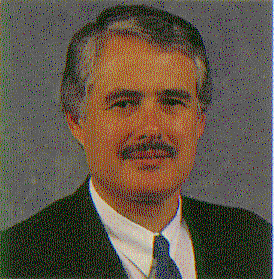
Spring/Summer 1999
Volume 6, Issue 2
Spring/Summer 1998
Volume
3, Issue 1
January 1995
Volume
2, Issue 4
October 1994
Volume
2, Issue 1
January 1994
Parallel Profile: Ken Kennedy
Noah Harding Professor, Computer Science, Rice University and Director, Center for Research on Parallel Computation
 Ken Kennedy's research interests range from parallel computing in
science and engineering to the design and construction of compilers and
programming environments for high-performance computers. His current
work focuses on extending techniques developed for automatic
vectorization to build new programming tools for parallel computer
systems and high-performance microprocessors. Through the CRPC, he is
seeking to develop new strategies for supporting architecture-
independent parallel programming.
Ken Kennedy's research interests range from parallel computing in
science and engineering to the design and construction of compilers and
programming environments for high-performance computers. His current
work focuses on extending techniques developed for automatic
vectorization to build new programming tools for parallel computer
systems and high-performance microprocessors. Through the CRPC, he is
seeking to develop new strategies for supporting architecture-
independent parallel programming.
Kennedy's interest in computing began early in his adult life. As a Rice undergraduate, he used an IBM punch-card computer for mathematics assignments and physics lab analyses and became fascinated with what it could do. This fascination eventually turned into a career. After receiving a doctorate in computer science from New York University in 1971, Kennedy returned to Rice and has been there ever since. Among his accomplishments, he has published more than 100 technical articles and supervised 23 Ph.D. dissertations on programming support software for high-performance computer systems. In addition, he has designed and supervised the construction of two major software systems for programming scientific machines: an automatic vectorizer for Fortran 77 (with Randy Allen) and an integrated scientific programming environment (with Keith Cooper and Linda Torczon).
In addition to directing the CRPC, Kennedy has chaired the Computer Information Technology Institute at Rice and the Rice Computer Science Department. He was elected to the National Academy of Engineering in 1990 and named a fellow of the American Association for the Advancement of Science in 1993. From 1991 to 1992, he served on the High Performance Computing and Communications subpanel of the President's Council of Advisors on Science and Technology. He has also served as an editor for several professional journals and has consulted extensively for public and private organizations. As director of the CRPC and a professor at Rice, Kennedy wears many hats, an experience that he relishes. "I really enjoy both administration and research, which are at opposite ends of the spectrum," he said. "I like thinking long-range, planning things out, and building a vision for an overall research effort. With parallel computing, for instance, I think that we can have a real long-term impact on society and the economy. The other part of my work involves collaborating with students, research scientists, and other faculty on research problems. Getting to the heart of problems in parallel computing definitely makes my work more enjoyable.
"For example, how do we develop a programming system that is independent of any particular target machine? This problem has been approached from several different angles and we are having some impact on the computing community. We've built prototypes, such as Fortran D, in which several companies are interested. We've also been working on setting standards for parallel languages. Standards are never easy, but the outcome of the High Performance Fortran standards effort will have a great impact. We've worked with people from around the world on these standards and, collectively, the standards promise to be a major part in solving the parallel computing problem. The pieces are definitely coming together."
Table of Contents